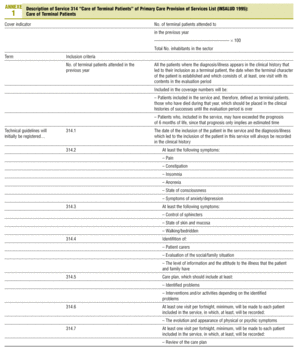Key Points
* The implementation of palliative care programmes is a priority need in all health care settings.
* The development of these programmes must result in an increase in the role played by the different field of care and avoid replacing the different professionals involved in the care of patients at the end of their life.
* Primary care must fully assume its crucial role in the care of patients at the end of their life.
* The creation of suitable quality care indicators to evaluate these programmes would help us assess them better and be able to use corrective measures where necessary.
Since the beginning of the 1970's, when the basis of palliative care was established, until the present day, we have witnessed a progressive awareness in health circles on the importance of the care of terminally ill patients. Despite the principles of this care fitting perfectly within the conceptual elements of primary care,1 a progressive loss of its prominent role in taking on the care of the terminally ill patient has occurred for several reasons: increased dependency by the patient on the hospital services, coordination difficulties between health settings, organisational problems, and lack of specific training.2
In recent years, international bodies have emphasised the need to set up palliative care programmes in all health care fields.3
Our country has adopted those recommendations. It is obvious that integrated models are required which allow training in all health care settings will make it easier to coordinate the care of patients at the end of their life and will work according to the complexity of each case. The problem stems from the specific model adopted. Given the clear preference of the patients to remain at home, it seems obvious that these programmes should be based in primary care. A review of studies on patient and carers satisfaction with different models of palliative care concluded that the home care models were better received and, among them, the programmes based on primary care were more valued than those dependent on hospital services.4
Studies carried out using questionnaires sent to family doctors on models of palliative care organisation in countries who have implemented these services over a relatively long period found that those services closer to primary care were better valued. Although there is a high satisfaction with these services, they particularly mentioned lack of coordination and flexibility to carry out a proper shared care.5,6 However, there are few studies which evaluate the impact of these programmes on the primary care activity regarding terminal patients.
The study by Rocafort et al attempts to answer the question of whether it is really possible to develop a second care level that may give support and not replace the first care level. This question is crucial, as one of the basic objectives of support teams is to promote adequate care at the end of life in primary care and not to act independently. The results of their study indicate that this can be achieved. The authors found two support team activity variables particulary associated with the increase in activity by primary care teams with these patients: joint visits and teaching sessions. These results are not surprising. Given the complexity of domiciled patients, it has been proposed for several years that a shared care model could be a suitable response. On the other hand, there is a definite need for specific training, and one of the best ways to achieve this is the analysis of real cases. However, the study has obvious limitations. It is a retrospective study and may also be influenced by the derived effect of the first years of activity of the programme.
Therefore, these results must be confirmed in the next few years, when the programme is definitely consolidated. On the other hand, the results of the programme have not been evaluated, just the process indicators. We would need to confirm that the activities carried out are accompanied by improved care of terminal patients.
In our opinion, the most important value of this study is its contribution in creating indicators of care quality of support teams. The basic function of these groups is to contribute to improving the care of patients at the end of their lives, particularly through better training of primary care teams and improving coordination with other health areas to ensure continuity of care. The implementation of these programmes has to have an adequate system of evaluation that will ensure completion of the objectives for which they have been created. This study provides us with some indicators which could be useful. Firstly, to include its activity in the normal primary care record systems and to comply with the criteria of only working by request of the corresponding family doctor. Secondly, to ensure shared care by means of joint visits and teaching sessions. Lastly, we have to be capable of creating easy to use evaluation indicators that can measure whether the coordination is functioning well and in particular, the overall results. Insofar as we are capable of creating these evaluation tools for primary care programmes, we should be able to measure their effectiveness and ensure the necessary development of primary care.7 Otherwise, these programmes, and particularly the support teams, will not improve the primary care field as a whole, and at the most, would benefit few patients.











